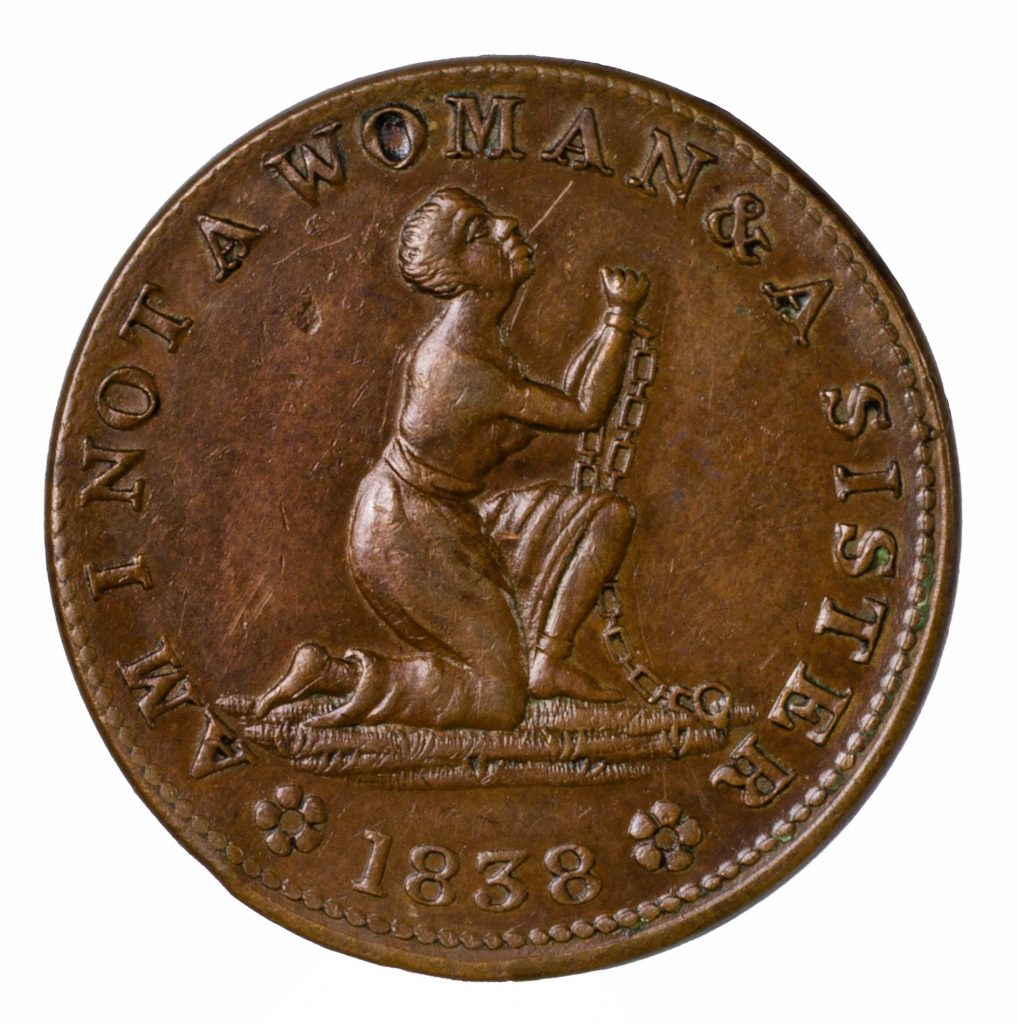This project focuses on traditionally valuable objects that convey a political message, which was not typically projected onto the elites. There is an added layer to the overlap between relationships between Suffragettes and Abolitionists belonging to imperial powers. The first object in this analysis is a silver coin, minted 1892, decorated with a Golden Jubilee portrait of Queen Victoria. It’s unique in the representation of the political climate of the time as it was defaced by the prominent suffragette group, Women’s Social and Political Union, in the early 20th-century. In Britain, the abolitionist movement made headway in the 19th century. Ideology spread through typical monied objects, such as medallions, coins, jewelry, and luxury ceramic goods. Am I not a man and a brother created by a renowned ceramicist, who has received commissions from the monarch itself, created a collection of anti-slavery goods to spread the movement’s message. Josiah Wedgwood’s confection of high status goods and revolutionary abolitionist support reinvented the mode in which a political message could be spread to a group who is usually unwilling to listen. Disguised in pristine bone white china, Wedgwood made abolition a product of consumption so the elites who had benefited from slavery the most. The final object, Am I not a woman and a sister, brings together the messages of abolition and women’s rights together. Featuring an enslaved woman, the coin uplifted the voices of women affected by slavery and also those fighting to end it. The intersections of each object encapsulate the ways in which money and valuable goods were used as a protest against the very systems that controlled them.
Women’s Suffrage Coin
On the obverse of the silver coin has an engraving of Queen Victoria’s Golden Jubilee portrait, and was minted in 1892 as is indicated on the reverse. The prominent militant suffragette group, the Women’s Social and Political Union, carved “Votes for Women” on the obverse as political protest. On the reverse of the coin is an official engraving of a Trojan soldier atop a rearing horse stabbing a dragon with his sword. The letters “WSPU,” standing for the Women’s Social and Political Union, who are responsible for the defacement, are engraved over the horse and dragon.


Anti-Slavery Mug
This pristine white bone china mug was designed for exportation by an abolitionist movement. There is but one image on the mug, that of a shackled kneeling enslaved African, surrounded by a tropical environment. The Am I not a man and a brother? emblem was a recurring image for the British Anti-Slavery movement carried forward by Thomas Clarkson and William Wilberforce. By 1807, and before the abolition of slavery in all the British colonies in 1838, many versions of the kneeling slave found their way onto the surface of artifacts made in ceramic, metal, glass and fabric. The golden detailing and bone china entice an audience of exorbitant taste to consume abolitionist messaging.

Hard Times Token
The token, “Am I Not a Woman and a Sister?” from 1838 was created at a time of multiple crises. It was minted during the “Hard Times” era of economic crisis, in which Andrew Jackson closed the Second Bank of the United States, removing vast amounts of coinage in circulation. Simultaneously, slavery was still thriving in the United States, but not without opposition. The economic crisis allowed private minters to create coinage used as legal tender, thus leading to the use of coinage as a tool for spreading political messages. This particular token was sponsored by the American Anti-Slavery Society and depicted an enslaved woman as a symbol for the exploitation and torment of slavery. Women as a symbol of protest was rare, and held particular meaning for activist women. Coinage was also a unique tool for protest in its ability to hold political significance on a functional, everyday object.



Comments are closed, but trackbacks and pingbacks are open.